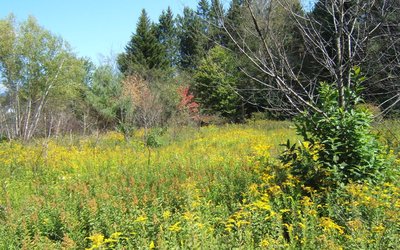Insect biodiversity is changing because of agriculture and climate change
June 29, 2022

Joint impact
Insect biodiversity declines because of intensive agricultural land use, the loss of natural habitats and climate change. As a result, the provision of ecosystem services essential to agriculture, such as pollination and pest control, also declines. In fact, the resilience of natural and agricultural ecosystems to future shocks such as those from extreme climatic events may deteriorate. The impacts of agriculture and climate change are related: observations from around the globe suggest that high-intensity agriculture makes insects more vulnerable to climate change. Insect biodiversity would probably benefit from mitigating climate change, preserving natural habitat within landscapes and reducing the intensity of agriculture.
The impact of the combination of these drivers – agricultural land use, the loss of natural habitats and climate change – has been studied by analyzing more than 750,000 records for almost 18,000 insect species at the global scale. This database includes snapshot samples of terrestrial biodiversity from different locations across the globe, enabling spatial comparisons of sites under different land-use and climatic conditions.
Higher intensity agriculture = stronger impact climate change
The observations in the database indicate that the combination of intensive agriculture and climate change has led to large reductions in insect biodiversity. Intensively used agricultural systems that experienced substantial climate warming showed 49% and 27% reductions in insect abundance and species richness, respectively, compared with those in natural habitats with no climate warming. Under the same level of climate warming, low-intensity agriculture experienced 30% and 23% reductions in insect abundance and species richness, respectively.
More natural habitats = more resilience to climate warming
Insects are highly sensitive to climate warming and need close access to shady conditions to survive the warmest parts of the year. Agriculture reduces the availability of these nearby conditions and makes insects more vulnerable to the effects of climate warming.
When the intensity of agriculture is low, the effects of climate warming can be largely offset by making sure that enough shady conditions – natural habitats – are available nearby. In low-intensity agricultural areas where the surrounding natural habitat covers 75% of the land, insect abundance and species richness are reduced by 7% and 5%, respectively, compared with natural habitats with no climate warming. When only 25% of the natural habitat cover was present, these reductions were 63% and 61%, respectively. This suggests that nearby natural habitats can mitigate the effect of climate warming in low-intensity agriculture if these habitats cover a sufficiently large area.
In low-intensity agriculture, incorporating natural habitats into agricultural landscapes can promote the maintenance of local insect biodiversity. This does not hold for high-intensity agriculture areas, however. According to observations in these areas, a buffering effect of nearby natural habitats was smaller or non-existent.
Preserve insect biodiversity: less intensive agriculture + more natural habitats
As the global demand for food increases, it is likely that the expansion of agricultural systems will continue. If this agricultural expansion is associated with a reduction in the availability of natural habitats within production landscapes or a move toward higher-intensity agriculture, our results indicate that large declines in insect biodiversity will occur, particularly as climate warming accelerates. On the other hand, the ability of natural habitats to mitigate the negative impacts of agriculture and climate change in low-intensity agriculture presents a management option that could help to maintain insect populations.
Insect biodiversity is essential for many ecosystem functions and services, including key services for agriculture. Ensuring that these services remain available in agricultural landscapes will benefit people and nature. Under the highest-emissions scenarios, most of the terrestrial surface will be exposed to novel high temperatures by 2070. Reducing the magnitude of changes in insect biodiversity will require strong climate mitigation and implementation of land-management strategies that increase the availability of natural habitats.
Source: Outhwaite et al., 2022. Nature 605: 97-102.








